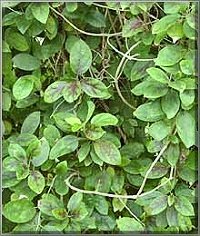
Gymnema sylvestre

Gymnema sylvestre
Description: Gymnema sylvestre is a woody, vine-like plant which climbs on bushes and trees in the Western Ghats in South India, and to the west of those mountains in the territory around the coastal city of Goa. The medicinally active parts of the plant are the leaves and the roots. It came to be known as "destroyer of sugar" because, in ancient times, Ayurvedic physicians observed that chewing a few leaves of Gymnema sylvestre suppressed the taste of sugar. That is, sweet foods no longer tasted sweet, but rather became almost completely tasteless. In later generations, clinical tests showed that regular use over a period of three to four months helped to reduce glycosuria, or the appearance of carbohydrates in urine. Recent clinical trials conducted in India have shown that an extract of Gymnema sylvestre is useful in both insulin-dependent diabetes mellitus (IDDM) and in certain specific types of non-insulin-dependent diabetes mellitus (NIDDM).
As a result of these clinical tests and years of successful treatments, Gymnema sylvestre is used today all over India for treating diabetes mellitus. In reducing the symptom of glycosuria, the dried leaves are used in daily doses of three to four grams for a period of three months or more.
Studies conducted in India as early as 1930 showed that the leaves of G. sylvestre cause hypoglycemia in experimental animals. This state of hypoglycemia is explained on the assumption that the drug indirectly stimulates the insulin secretion of the pancreas, since it has no direct effect on the carbohydrate metabolism.
How Gymneme Sylvestre works - Recent pharmacological and clinical studies have shown that Gymnema sylvestre acts on two sites: first, the taste buds in the oral cavity; second, the absorptive surface to the intestines.
The structure of those taste buds which detect sugar in the mouth is similar to the structure of the tissue that absorbs sugar in the intestine. The important active ingredient of G. sylvestre is an organic acid called "gymnemic acid." The gymnemic acid is made up of molecules whose atom arrangement is similar to that of glucose molecules. Those molecules fill the receptor locations on the taste buds for a period of one to two hours, thereby preventing the taste buds from being activated by any sugar molecules present in the food. Similarly, the glucose-like molecules in the gymnemic acid fill the receptor locations in the absorptive external layers of the intestine, thereby preventing the intestine from absorbing the sugar molecules.
It has also been noted that Gymnema sylvestre takes away the bitter taste of bitter substances, such as quinine, in much the same way that it affects the sense of sweetness associated with candies and other sweet foods. However, it has no effect on pungent, salty, astringent or acidic tastes. Therefore, if you are eating an orange within two hours after chewing Gymnema sylvestre leaves, for instance, you would taste the sourness of it but not the sweetness.
Practical Uses - The benefits of Gymnema sylvestre are two-fold:
Treatment of Diabetes - Trials under experimental and clinical conditions have shown significant results in the treatment of diabetes. Remarkably, unlike insulin or oral hypoglycemic suphonylurea compounds, the hypoglycemic effects of Gymnema sylvestre are seem in only a small percentage of the diabetic patients. For most people, blood sugar lowers to normal levels; it does not lower to a point below normal blood sugar levels. This can happen in a small number of patients, however, because the mechanisms of the diabetic syndrome vary with different patients. In recent years IDDM has been observed to have entirely different pathophysiology and clinical course from NIDDM. The studies have suggested that Gymnema sylvestre may be useful in certain specific types of NIDDM, in addition to its general usefulness in IDDM.
The safety of Gymnema sylvestre has been demonstrated by the fact that it has been safely and successfully used for more than 2,000 years in traditional Ayurvedic medicine.
Other Uses of Gymnema Sylvestre: